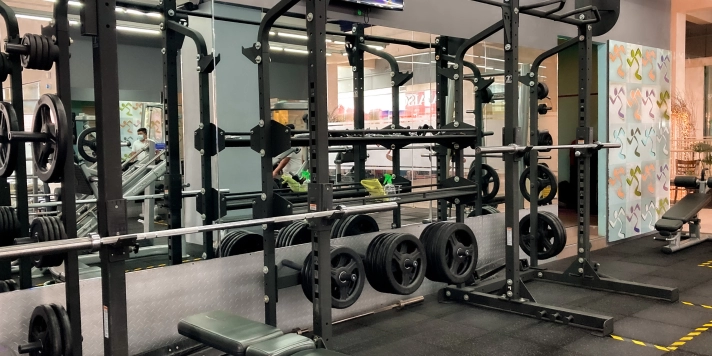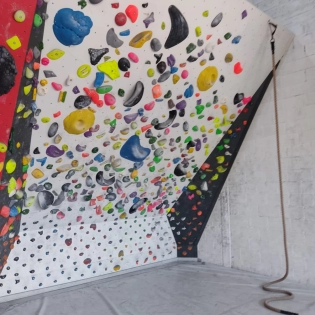








training
Depends on who you ask, for me, they count as both climbing and training.
I have a MoonBoard at my gym, and I usually prefer to climb on it rather than training on a hangboard. Though I do have at least 1 session a week for hangboarding and campus runs, I do prefer to climb on the MoonBoard because it's just more enjoyable compared to just hanging off of an edge. On a MoonBoard, you are also training crimps, and pinches, and you are also just climbing. Not to mention that you also train your core and back and other muscles while doing it, in comparison to hanging on a hangboard, where you train mostly your fingers, and just hang.
So for me, it is training, and it is also climbing, even though the climbing on it is very different from climbing on a regular climbing wall, but every so often you get a boulder route that is very similar to a MoonBoard problem, and if you climb regularly on a MoonBoard or other board wall, those routes will be much easier.
Squats are a great overall leg exercise. The exercise really hits the major muscles in your legs that can help with climbing.
You don't even really need to add any weight to this exercise. Depending on your goals, if you just want to improve your leg strength for dynamic movements in climbing, even squatting with body weight can be enough.
If you want to go that extra mile, you can do a jump squat.
A jump squat is when you do a regular squat, but as you rise up, instead of just standing up, you jump as high as you can. This can help give you that extra strength training to get better at those dynamic climbing moves where you have to jump and reach a far away hold.
Other than squats, calf raises is another great exercise. All you need to do is to find a step or an edge to stand on with your toes, and you just raise yourself as high as you can while staying on your toes, and then you just lower yourself until your heel touches the ground. The higher the surface you are standing on, the lower you will have to go to touch the ground, which means it will be harder to complete the exercise.
If you feel that it gets too easy, you can hold a dumbbell or any other weight in one of your hands for extra difficulty.
Rock climbing is a great full body workout, especially if you are a beginner, or you have never done it before.
Rock climbing heavily targets your back, arms, and core. In addition to these muscles, which are the most worked muscles while climbing, you will also use your feet, triceps, and occasionally, your chest for certain moves. Most likely all parts of your body will be used while climbing at times, it depends on the level of climbing, the difficulty of the route, and the route itself.
It's not uncommon for new climbers to be sore in places they have never been sore before. This is because climbing uses many smaller muscles that people normally do not use, even if they are coming from a history of other sports or weight training.
In addition to the smaller, mostly unused muscles, it also uses your main muscles in ways that you may normally not use. This is because in order to stay close to the wall, you have to sometimes put your body in positions that may be quite awkward to your muscles since they are positions your body just isn't used to, which means you will use your muscles to get in and out of those positions in ways they are not used to.
Rock climbing can broaden your shoulders, but it depends on how your body reacts to training.
I am normally pretty skinny, with not too much muscle. But, when I climb, I gain quite a bit of muscle mass, which makes it seem as if I have been lifting weights for a while. I very often get asked how I work out and how much weight I lift, which I don't, I just climb and at the most do body weight training such as pull-ups.
On the other hand, I have friends who climb and train almost exactly like me, who eat better also, but don't gain weight or muscle mass like I do.
So it really depends on your body and how it reacts to training. Some grow faster than others, some get stronger than others.
Not really. Climbing is more of a pulling exercise for the upper body. This basically leaves your chest and triceps sort of neglected, which is why many climbers do antagonist training such as push-ups, dips, and bench presses.
There are some climbing moves such as mantles that use your triceps, and to some very slight extent, your chest. But for the most part, your chest is not used enough to build it a lot, at least not as much as your other muscles are used, such as your back. Which, again, will cause an imbalance in your muscles if you don't train your chest and triceps specifically. Your posture could be effected by this quite a lot.
Training antagonist muscles is very important for proper muscle balance and to prevent injuries.
Push-ups are a great way to train the antagonist muscles. It targets your chest muscles, triceps, and shoulders. There are also many different variations of push-ups that can make them more challenging, difficult, and effective.
Here are some of the different push-up variations:
- Close hands
- Wide hands
- Unbalanced hands (one hand up high, the other lower down), this puts more emphasis on different muscles for each arm
- Leaning forward
- Elevated feet
- Handstand push-ups
- Adding weights on your back
Climbing is mostly a pulling sport for your upper body. You will spend most of your time pulling with your arms, and pushing with your feet. But, there are times and certain moves in climbing that require you to push with your arms, such as when doing a mantle. This is where having strong triceps and chest muscles can be useful.
The chest muscles are some of the only muscles that are not directly worked when climbing. Climbing does build many muscles in the body, even legs to some extent, but the chest muscles are just barely used while climbing.
While climbing, your body is under general tension, and there are specific moves that do use the chest muscles, but they don't occur so often as to actually give your chest a good enough workout.
This is why climbers should also include antagonist training and exercises into their schedule to help build the muscles that are not really worked enough through climbing, otherwise they could suffer muscle imbalances that eventually could lead to bad posture and to injury.
If you don't have a gym, there are still plenty of exercises that you can do that can make you a stronger climber.
Depending on where you live, your best bet may be to just find a playground, they usually have pull-up bars and other equipment that you can do some body-weight exercises.
You can do pull-ups and all of its many variations. Push-ups and all of its variations. Running, sprinting, or jogging for legs. You can also do squats and calf raises, which are great.
You can also either buy or make a hangboard and a pinch block. These are the two classic climbing exercise equipment. The pinch block would be the easier to make, or the cheaper to buy, it's really just a block of wood with a hole in the middle of it to attach a rope and weights to it. The only issue is that you need weights for this to be effective, or something heavy that you can attach to it, like a heavy rock.
Other than that, if you can get a hangboard, that will be your next best option. Hangboards are used for training your fingers by hanging from them from your fingertips. Be warned though that it is very easy to injure yourself on hangboards, and most suggest only doing it after 1 year of climbing.
I always go for body weight exercises. There are always exercises that you can do to challenge yourself and that you can find hard, like learning to do handstands and doing handstand push-ups.





